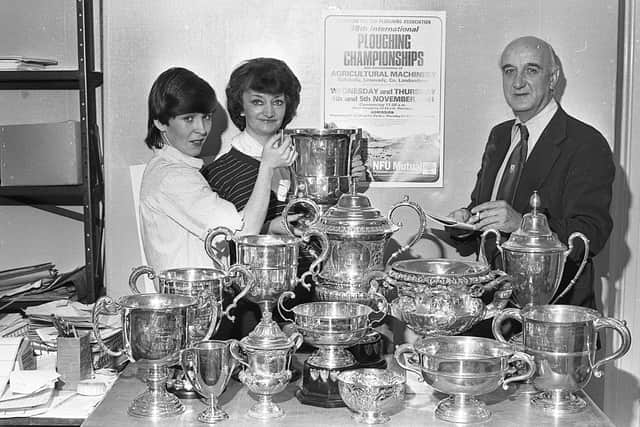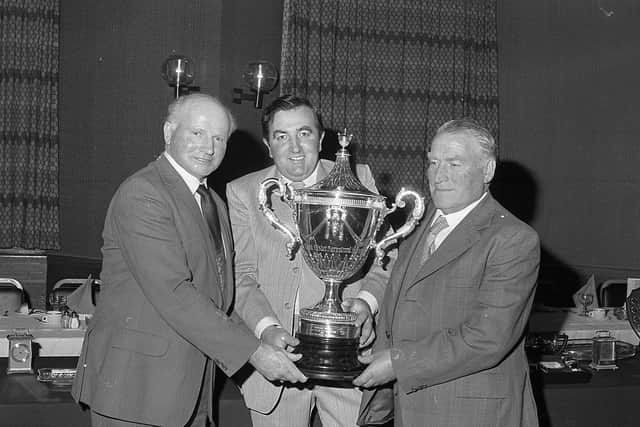Keen prices at New Year fairs held across the province of Ulster (1924)
and live on Freeview channel 276
On January 1 at Omagh, the News Letter reported: “Held in mild weather. There was a good attendance of buyers, but small supply cattle, with the exception of beef.
“There was big display of fat bulls, which were selling at reduced prices – fully 5s per from the last fair. Best bullocks heifers 45s to 50s per cwt; bulls 30s to 37s 6d; springers, shown in small numbers, prices, which were rather easier, £20 to £24 and £16 to £20; small supply of yearlings, £8 to £10; six quarter-olds £10 to £12, two-year-olds £12 to £14.”
Advertisement
Hide AdAdvertisement
Hide AdOf the sale held at Gortin on January 2, 1924, the News Letter noted: “A good demand for beef class of cattle, especially for milch and cows for milk purposes.


“Beef, best quality, 40s per cwt; second quality 35s to 40s cwt; springing cows, best class, £20 to £25; second class £20; milch cows, best class, £14 to £18 10s, second class £11 to £14; springing heifers £12 to £17 10s; three-year-old bullocks, £16 to £19; two-year-olds, 10s £16; six-quarter-olds to £11 10s; year-olds £6 to £6 15s; dry heifers £8 10s to £11 10s; cattle for fattening purposes, first class, 10s, second class to £11 10s; weanling calves 15s, newly-dropped calves 5s to 10s; minchers, best class, £8 10s to £12, second class £5 5s to £8; fat bulls for beef, best class, £20 to £25, second class £16 to £20; fat cows, best class, £15 to £20, second class £12 10s to £15.
It continued: “Fat sheep £3 15s to £4 10s; fat lambs £2 10s, mountain or horned sheep £2 to £2 10s, mountain lambs, 16s to 27s.”
Meanwhile there had been a “good strong demand” for general horses for “all manner of farm work” with price from £12 to £19, driving horses £10 to £18, old agricultural horses £5 to £10, hacks £3 10s to £5 10s.”
Advertisement
Hide AdAdvertisement
Hide AdOf the fair which was held on January 5, 1924 at Cookstown, the News Letter reported: “Supplies on the small side, but demand good. Quotations – Springing heifers, first class £20 to £25, second class £12 to £20; springing cows, first class £24 to £30, second class £15 to £24; milch cows, £22 to £28; strippers, first class £12 to £16, second class £8 to £12; three-year-olds £22 to £24, two-year-olds £16 to £20, one-year-olds to £12. There was a small show of fat cattle and saw 47s 6d per cwt live weight, as the top price. Fat sheep realised from £5 10s to £4 10s, while those of the mountain variety were from £2 10s each down.”


Of the sale held at Fivemiletown, also on January 5, 1924, it was noted: “A good supply stock, prices and demand showing little change a month ago. Quotations - Strong well-conditioned heifers and bullocks over two and under three years £15 10s to £19 10s, over and under two years £10 10s to £15 10s, year-olds £7 10s to £9 10s; weanling calves, £3 to £4; dropped calves, 15s to 21s; best springers £24 10s to £28 10s, second and third classes £17 30s to £21; best milchers £19 to £22 10s, second and third classes to £14 10s, cows, dry cows, and strippers, £9 10s to £12 10s; fat sheep, £4 10s to £5 10s; lambs, £2 10s to £3 5s.”
A sale had also been held at Clogher on January 5, 1924, the News Letter reported of this sale: “Supply was scarcely up to the average of a month ago, with demand and prices for springers and well-conditioned stores pretty good. Quotations - Superior springers £23 to 10s to £25, second and third classes £16 10s to £20 10s, best milchers £17 to £21 10s, second and third classes £13 10s to £16 10s; two and three-year-old heifers and bullocks £14 10s to £18 10s, six-quarter-old £9 to £12 10s, yearlings £5 10s to £8 10s, weanling calves, £2 10s to £3 10s; dropped calves, 15s to 20s, aged cows, dry cows, and strippers, £10 10s to £13 10s, brood sows, £5 10s to £6 10s; fat sheep £4 to £5, lambs to £2 10s.”
Across the border in Donegal at Stranorlar, the report for the sale on January 5, 1924 read as follows: “All qualities of best stock were bought quickly, and there was a good demand. Beef best quality 45s to 50s, second quality 40s to 45s per cwt, springing cows, best class £21 to £26, second class £16 to £20; milch cows, beef class £15 to £19, second class, £12 to £15; springing heifers, best class £18 to £22, second class £14 to £18, three-year-old bullocks, £17 to £18 10s, two-year-olds, £14 to £15 10s, six-quarter-olds, £10 to £11 10s, year-olds, £6 15s, dry heifers, £8 to £11, cattle for fattening purposes, best class £12 to £15, second class £8 10s to £12; weanling calves, £2 10s to £3 5s, newly-dropped calves, 5s to 10s; mincers, best class £11 to £12 10s, second class, £5 10s to £10; fat bulls for beef, best class, £2O to £23, second class £17 to £2O; fat cows, best class to £2O, second £14 to £16.”